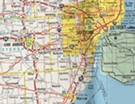
From Motor City to Motor Metropolis: How the Automobile Industry Reshaped Urban America
Building the Motor Metropolis: Automobiles, Highways, and Sprawl
Increasingly public policy oriented itself toward car drivers. Funds for public transportation plummeted, leading to a decline in ridership and service cuts that accelerated overtime in a feedback loop. The city's public transit system declined, leading to service cuts that accelerated over time and declining public support for transit. It seemed somehow appropriate that the city that had given birth to the automobile industry had one of the nation's poorest and least accessible public transit systems by the end of the twentieth century.
As buses and trolleys languished, expressway construction boomed, particularly after the passage of the Interstate Highway Act of 1956. In Detroit, as in the nation, federally-funded highway construction (and later expansion and maintenance projects) dwarfed public works projects of the past. Huge swaths of city were demolished to make way for expressways--and as was the case with so many urban redevelopment projects, black working-class neighborhoods were most heavily impacted. The Chrysler Freeway blasted through the heart of Paradise Valley, replacing Hastings Street, one of black Detroit's main shopping and entertainment districts. The Lodge and Ford Freeways cut through the city's most established black west side neighborhoods. By the end of the 1960s, it was possible to pass through vast sections of the city at sixty or seventy miles per hour on submerged, limited access highways.
New expressways accelerated the process of suburbanization. New housing developments for both blue and white collar workers sprung up virtually overnight in what had been rural areas on the outskirts of the metropolis. The largest blue-collar suburb (and soon the third largest municipality in the state) was Warren. A community of truck farms before World War II, by 1960, it was home to over 150,000 people who lived on streets lined with block after block of little ranch houses and Cape Cods. Warren and suburban Macomb County (of which it was a part) became a Mecca for blue-collar whites fleeing the city. White-collar workers also filled up new subdivisions as quickly as they could be built in the city's northern and western suburbs. Wetlands and farmlands alike became seas of green lawns, divided by ribbons of tarmac. By 1960, more whites in metropolitan Detroit lived in the suburbs than in the city (though very few blacks did--because real estate agents refused to sell to them and they faced intense hostility and often violence when they tried to cross suburban boundaries).
Over the course of the twentieth century, the Motor City had become the Motor Metropolis, going from twenty square miles to several thousand square miles. As the population spread outward, the whole urban landscape changed. The rapid development of suburban tract housing greatly strained municipal resources. The old, narrow, sometimes even unpaved roads in new suburbs could not accommodate the flood of cars that accompanied suburban development. Faced with massive traffic jams, suburban communities scrambled to raise funds to retrofit the old, narrow, sometimes even unpaved roads that had been built to serve sparsely populated, rural areas. Wider roads did not, however, reduce traffic--in fact traffic engineers discovered that "if you build it they will come." Although many suburbanites claimed that their new communities offered a haven from urban "congestion," suburban roads were often more clogged with traffic than their counterparts in the depopulating center city.
Detroiters--like their counterparts in most of the United States--spent more and more time in their cars. The landscape of the metropolitan area reflected the new dependence on the car. New auto plants, office parks, and shopping centers, were now surrounded by acres of parking lots to accommodate commuters from all corners of the metropolitan area and even sometimes from further afield. At major intersections and near expressway exit ramps, new commercial enterprises--gas stations, car dealerships and repair shops, fast food restaurants, drive-ins, shopping centers, and strip malls--sprung up to cater to automobile users. In suburban Detroit, as in large parts of late-twentieth century America, pedestrian life dwindled. Most suburban developments dispensed with sidewalks altogether; children were more likely to be driven or bused to school; church yards were dwarfed by parking lots. The car culture even transformed residential architecture. The most prominent visual feature on most post-World War II homes was the garage.
The automobile was, by far, the most expensive consumer good (other than the house itself) that most Americans owned. But despite their expense, cars were not built to last forever. Each year, auto makers introduced new models, highlighted new features and designs, and celebrated new features. Many commentators described auto design as "planned obsolescence"--the design, the fashion, the very appearance of the car was meant to be fleeting, to be obsolete. So too did manufacturers treat the facilities that constructed automobiles. Many of the first auto plants were massive, architecturally impressive structures. Albert Kahn, one of the leading architects of the early twentieth century, designed Ford's Highland Park plant and many of the city's leading factories. But by the 1950s, auto companies were beginning to jettison rather than to redesign or recycle old plants. One by one, they replaced the grand structures of Kahn and his imitators with new facilities. The auto plant proved to be just as much a victim of the mentality of planned obsolescence as its final product. "Obsolescence," wrote Henry Ford II in response to critics of plant closings, "is the very hallmark of progress."
<<Previous Section - Next Section>>
Becoming the Motor City: Immigrants, Migrants, and the Auto Industry
Living in the Motor City: Autoworkers, Race, and Urban GeographyBuilding the Motor Metropolis: Automobiles, Highways, and Sprawl
Moving Out: Decentralization and the Decline of Urban Factories
Downsizing: Depopulation, Disinvestment, and the Fate of the City
Complete Text Printable View
About the Project | Credits | Contact Us | Student & Teacher Resources | Site Map
©2004 Automobile in American Life and Society






